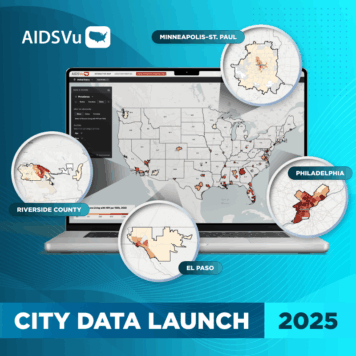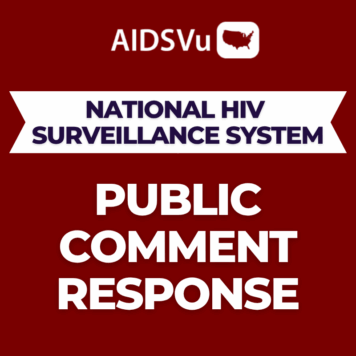New paper uses real-world data to show population-level impact of PrEP coverage
Atlanta, GA, May 27, 2025 – New study released today shows that states with the highest levels of pre-exposure prophylaxis (PrEP) coverage in the U.S. have seen a 38% decrease in new HIV diagnoses over the last decade. Conversely, states with the lowest levels of PrEP coverage saw a 27% increase in new HIV diagnoses between 2012 and 2022. The paper, “Association of state-level PrEP coverage and new HIV diagnoses in the USA from 2012 to 2022: an ecological analysis of the population impact of PrEP” in The Lancet HIV highlights the impact that PrEP, medicine used to prevent HIV infection, has had on advancing efforts to end the HIV epidemic in the U.S.
Increasing PrEP coverage is one of the key prevention strategies outlined in the federal Ending the HIV Epidemic initiative. PrEP medications are effective at preventing new HIV infections at the individual-level; this report extends data on the efficacy of PrEP by presenting the first comprehensive real-world data analysis showing the impact of PrEP at the population-level over a full decade. PrEP prevents new HIV infections and keeps communities healthy – lowering long-term costs to healthcare systems.
 Key Findings:
Key Findings:
- States with higher levels of PrEP coverage experienced larger decreases in new HIV diagnoses. A significant linear trend in the association of PrEP use and HIV diagnoses remained even after accounting for effects of varying levels of viral suppression among states on HIV transmission.
- Over the last decade (2012-2022), the 10 states with the highestaverage levels of PrEP coverage (highest quintile) saw a 38% decrease in new HIV diagnosis rates, adjusted for viral suppression.
- These same states saw an average decrease in new diagnoses of 5% year over year.
- Conversely, the 10 states with the lowest average levels of PrEP coverage (lowest quintile) saw a 27% increasein new diagnosis rates over the 10-year period, when controlling for viral suppression rates.
- These same states saw an average yearly increase in new diagnoses of 2%.
- Although the average PrEP coverage across the U.S. increased dramatically from 2012 to 2022 (0.6% to 26.3%), PrEP use among those who might benefit from it is still quite low. Expanding PrEP access is crucial to achieve the federal Ending the HIV Epidemic initiative’s goal of reaching 50% PrEP coverage.
“The bottom line is we know that PrEP works – for people and for populations. The data we published today show that when there are increases in PrEP coverage, there are corresponding averted infections and declines in new HIV diagnoses. However, many barriers to PrEP use still exist in this country. These barriers include limited access to healthcare coverage, a lack of nearby PrEP services in many areas, stigma, low awareness of PrEP among providers and individuals, and more.” said Dr. Patrick Sullivan, DVM, PhD, Professor of Epidemiology at Emory University’s Rollins School of Public Health, and Principal Scientist for AIDSVu.
“Recently, we’ve witnessed threats to federal domestic funding for HIV prevention and PrEP services. This paper demonstrates the progress that is at risk at the federal government level,” continued Sullivan. These efforts start at the local level, with PrEP education and outreach campaigns in highly impacted communities, PrEP provider education and training, and the expansion of PrEP services in a broad range of settings, including STI clinics and primary care clinics. These efforts must continue at the state government level with the implementation of PrEP Drug Assistance Programs and policies that improve healthcare coverage, including protecting access to Medicaid. State and federal policies should be adopted that require the coverage of PrEP medicines and ancillary services without restrictions, and that minimize cost barriers to accessing and staying on PrEP. It is critical that the state and federal governments continue to provide funding for these efforts. Doing so will avert new HIV infections, improve the health of Americans, and save healthcare costs by averting the long-term treatment costs of preventable HIV infections.”
The paper assessed both yearly- and decade-percent changes in HIV infections at the state-level based on annual average levels of PrEP coverage for 10 years (2012-2022), since the July 2012 FDA approval of the first drug for PrEP. PrEP coverage is the percentage of people who use PrEP, out of those with an indication to use PrEP (i.e. those who are HIV-negative and could benefit from PrEP based on their risk factors).
Full data methods and findings are available here.
More Data on PrEP:
AIDSVu, a leading HIV/AIDS data platform dedicated to making HIV data widely available, easily accessible, and locally relevant, recently released 2023 PrEP use data showing that while PrEP use has increased nationally by 17% from 2022 to 2023, regional and racial/ethnic inequities still exist, with greater unmet need for PrEP in Black, Hispanic/Latinx and Southern communities. These data underscore the importance of focusing PrEP programs and monitoring metrics on improving PrEP equity to prioritize communities with the greatest unmet need for PrEP.
AIDSVu is presented by Emory University’s Rollins School of Public Health in partnership with Gilead Sciences, Inc. and the Center for AIDS Research at Emory University (CFAR). AIDSVu’s maps and data demonstrate the need for further investments in health equity including mitigating effects of various social determinants of health such as lack of health insurance and poverty. There is still much work to be done to achieve health equity, improve the quality of life for people living with HIV, and end the HIV epidemic in communities across the U.S.
PrEP Data & Resources on AIDSVu
Through data incubation, analysis and visualization, AIDSVu and the PrEPVu platform offers an understanding of PrEP use across the country and the inequities that exist for the people and communities with the greatest unmet need for PrEP. Powered by AIDSVu, PrEPVu offers insights from data, research, and experts to promote data-driven public health policy and action.
Additional PrEP resources on AIDSVu include a Deeper Look: PrEP page providing further insights on AIDSVu’s PrEP use and PnR data, downloadable infographics and data sets, national, regional, state, and county profiles, and blogs by HIV experts. AIDSVu also features a PrEP Locator, a national directory of public and private practice providers of PrEP across the U.S. AIDSVu users can find local PrEP providers near them with this tool or overlay service locations on top of AIDSVu’s PrEP use maps.
PrEPVu Monthly
To further the conversation on PrEP equity, PrEPVu is publishing PrEPVu Monthly, a newsletter on the latest PrEP research, expert commentary, and important policy and community updates. Sign up here today.




